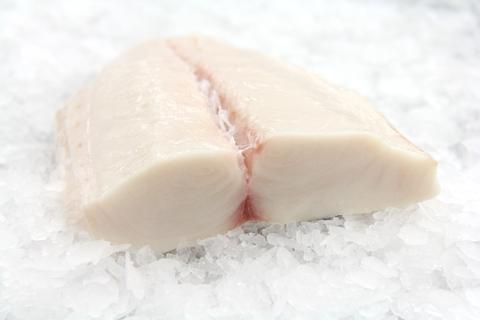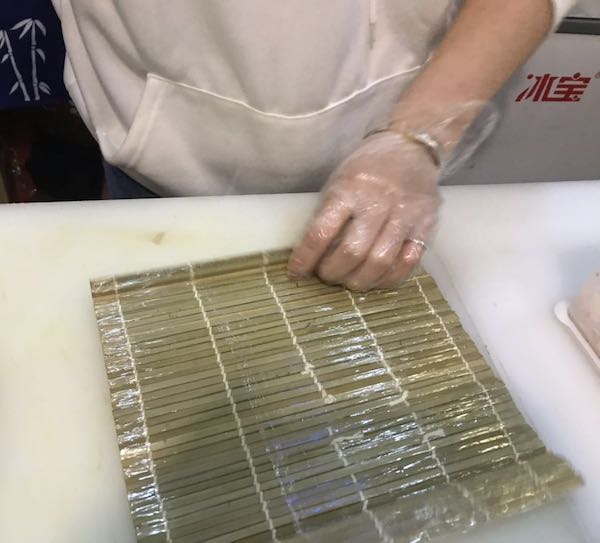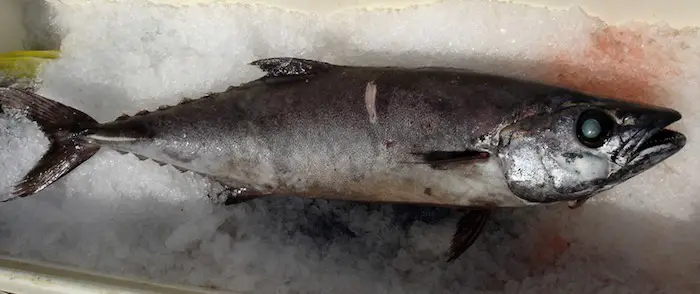We are reader supported. When you purchase through links on our site, we may earn an affiliate commission. Also, as an Amazon affiliate, we earn from qualifying purchases.

I am an ardent foodie and this incessant passion for food urges me to try new and exciting dishes that I have regretted at times. Last weekend, I was in a sushi restaurant and found this succulent and delicious looking raw fish that was labeled as ‘white tuna’.
I inquired further and discovered that this white-fleshed sashimi on rice was actually escolar, a controversial fish banned in several parts of the world. Also known as Walu fish or oilfish, Escolar belongs to the family of snake mackerel.
So, what is escolar sushi? Escolar is often passed as king tuna or super white tuna in maki rolls or nigirizushi in sushi restaurants. Although it has a rich and buttery texture, escolar sushi has a laxative effect on those who consume it.
The escolar sushi tastes incredibly good and those who are not aware of it may mistake it as white tuna due to improper labeling in restaurants. However, eating this delicacy in excessive amount may result in gastrointestinal distress that you may not want to suffer.
The fish contains a high percentage of oil or wax esters known as gempylotoxin. This substance can make you run to the bathroom several times after you consume the delicacy.
Contents
Why Is Escolar Known A Controversial Fish
The escolar fish is utterly delicious, buttery, succulent and cheap too! If you go to the local fish market, you may be surprised by the price tag on this fish. While the white fish tastes and looks great, it is still considered as controversial because consuming too much escolar results in abdominal pain, nausea, vomiting, and cramping.

The reason behind this is escolar fish’s diet which is high in wax esters that the fish cannot digest. Over time, these esters build up and the escolar cannot metabolize all that wax content. Similar in texture to mineral or castor oil, esters are responsible for giving escolars an oily texture.
Due to this nature of escolar, the Japanese and Italian governments have put a ban on import and sale of the fish. In Canada, Sweden, and Denmark, escolar fish must come with a warning label that explains its effects.
Escolar Sushi Recipe
This buttery and oily fish is delicious no doubt but can make you sick if over consumed. As a result, I choose to avoid raw fish and grill/ cook them when making sushi. Here are the instructions to prepare escolar for sushi.
• Seasoned sushi rice
• Escolar fillets
• Lemon juice, 2 cloves garlic and rosemary leaves
• Olive oil
• Nori sheets
• Japanese cucumber
Sprinkle salt and pepper on Escolar fillets
Rub with a mix of lemon juice, finely minced garlic, and chopped rosemary
Heat olive oil in a pan and add the fillets to oil
Cook for 2 minutes on both sides
Add some rice wine to the sides and cook for another 1 minute
When the fillets cool, use a sushi knife to cut them into long strips to be used as fillings
Prepare sushi rice at least 30 minutes before you plan to make escolar sushi. I have created an in-depth article on how to cook and season sushi rice perfectly.
Cut some veggies of your choice. I prefer using cucumber as the crunchy taste balances the buttery texture of escolar.
Place the bamboo mat on the table and put Nori sheet over it, shiny side facing downwards
Take a spoon of seasoned sushi rice and spread it on the Nori sheet
Arrange a few fish slices and cucumber strips towards your side of the Nori sheet

Lift the bamboo mat and start rolling to make a neat cylindrical shape
Take a sharp Japanese sushi knife and cut the roll into 6-8 pieces. Serve with soy sauce and wasabi
Pro tip: If you choose to consume Escolar raw fish in your sushi, make sure you do not exceed more than 5-6 ounce portion for an individual.
Difference Between Escolar And Tuna
Nutritionists may tell you to avoid escolar or eat in moderation, but it’s easier said than done. In the US, escolar fish is often subjected to food labeling fraud. Fishmongers often try to sell the fish as a delicious treat to ignorant buyers and sushi restaurants try to pass this as white tuna.
The flesh of escolar looks so similar to other fish that inexperienced eaters find it difficult to tell the difference. As it is relatively cheap than other species, it is often mislabelled and disguised as Albacore Tuna, Grouper, Black Cod, Butterfish, Chilean Sea Bass, Blue Cod, Pacific Cod, Rudderfish, and Atlantic Cod. Cheap sushi establishments may often try to dupe customers by feeding escolar instead of the fish ordered.
To be on the safe side, make sure you have an idea of what you are being served. Please bear in mind that albacore tuna is not entirely white, but has a pinkish hue to it. If the flesh is as white as snow then it is probably not tuna but a mislabelled escolar fish by all means.
You must also take a closer look at the texture of the flesh. Escolar usually has an opaque and shimmery appearance while the albacore will be translucent. When in doubt, always ask questions to the sushi chef.
If the raw fish on your nigirizushi tastes too buttery and looks very white then you can safely conclude that you don’t know what you are eating.
7 Tips To Stay Safe While Consuming Escolar
I know the feeling of craving for something that can likely make you sick. If you feel the urge to buy this significantly cheap fish at the fish market and the buttery taste seems irresistible, here are a few tips to help you stay safe.
#1. Limit the intake
The fish won’t kill you but can possibly make you very sick unless you limit the intake. When it comes to escolar, less is always more so make sure you don’t consume more than six-ounce portion. If you are eating this fish for the first time, I would recommend even a smaller portion unless you love the bathroom too much.
#2. Tail portion is the safest
The distribution of oil varies throughout the fish, and the cuts closer to the tail region usually have low wax ester count. So, tell your fishmonger to give you cuts from the tail area.
#3. Cook or grill the fish
If you have to eat escolar, at least consider grilling or cooking the fish. Wax esters are known to leak out of fish when grilled on high heat. This can also be achieved by baking the fish as esters collect in the pan below.
#4. Deep skinning can be the solution
In some species of the fish, the oil usually resides just beneath the outer skin. So, if you remove some of the flesh after the skin, you can reduce a significant amount of wax esters. This can somewhat lower the buttery content of the flesh, making it safer for consumption.
#5. Pre-existing medical conditions
If you are pregnant, lactating, or have previous medical conditions that make you allergic to escolar, make sure you stay away from this tempting white fish.
#6. Buy from a trusted fishmonger
There are several other varieties of fish that may have high levels of wax ester, so I recommend going to a reputed fishmonger. Escolars may also contain other toxins that result in food poisoning so always buy from a fishmonger you trust.
#7. Avoid cheap sushi restaurants
If a sushi restaurant serves you a fish you have never tasted before and it tastes too good to be true, take this as a red flag. Some sushi restaurants in the US serve escolar in the place of tuna and other fish varieties to save a few dollars.
If you experience symptoms of steatorrhea (abdominal pain, cramps, leaky bum) then take a note of what and where you ate. If these symptoms arise again for the second time you eat there, avoid that restaurant altogether.
What Happens If You Accidentally Eat Too Much Escolar Sushi
It can happen with anybody who is a food lover and likes to try out different restaurants. As per the researchers from the American Museum of Natural History and Columbia University, some of the high-profile sushi restaurants replace tuna with escolar without informing their customers.
This is scary because the effects of eating escolar can start showing within an hour of consumption, resulting in clear intestinal discharge and diarrhea. If you experience anything similar, plan your day close to the bathroom and replenish the toilet with some reading materials too. Eating escolar by chance will certainly not kill you but it can make you sick for 24-48 hours.
Related Questions
Why should I eat escolar then?
Despite the side effects of a leaky bum, people still love to eat escolar primarily for its rich buttery texture and delicious taste. Others eat it for adventure and to know what it feels like. Whatever is your reason to consume escolar sushi, make sure you buy from a trusted fishmonger or get it online from Catalina Offshore Products.
Where can you find escolar fish?
This species of fish is found in the tropical and temperate waters across the globe. It is typically dark brown in color and slowly becomes darker until it is totally black.
Can freezing reduce the oil content?
Freezing has no effect on the build-up of wax esters inside the fish and once the flesh is thawed, the buttery content remains almost the same.
See Also:
Does Sushi Make You Fat?
6 Sushi Tips For Beginners
How Often Can You Eat Sushi?
What is Nigiri Sushi? (Detailed Explanation)

